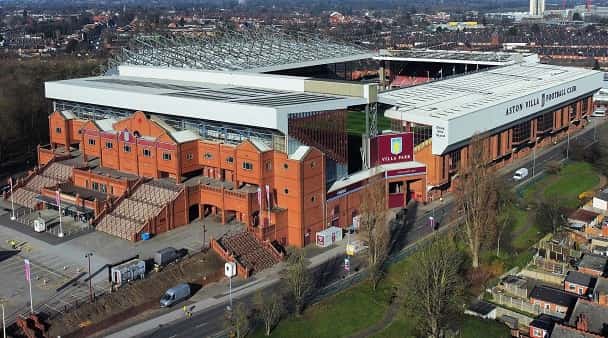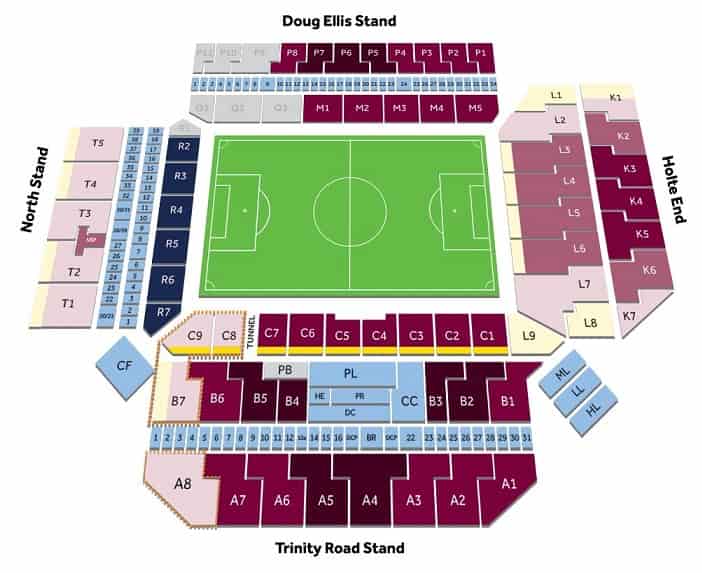Villa Park Stadium – Aston Villa

Address: Trinity Rd, Birmingham B6 6HE. Tel: 0333 323 1874
Villa Park Stats
| Villa Park Stadium | |
|---|---|
| Capacity | 42,657 |
| Away Capacity | 3,000 |
| Owner | Aston Villa Football Club |
| Year Built | 1897 |
| Average Attendance | 35,821 (2022-23 season) |
| Record Attendance | 126,047 (Aston Villa vs. Derby County, 1946) |
| Aston Villa Stats | |
|---|---|
| Year Founded | 1874 |
| Nicknames | The Villans, The Lions |
| Club Mascot | Hercules |
| Rival Clubs | Birmingham City, West Bromwich Albion, Wolverhampton Wanderers |
| Record Scorer | Steve Bloomer (253 goals) |
| Record Appearances | Jimmy Brown (763 appearances) |
| Owner | Nassef Sawiris and Wes Edens |
| Shirt Sponsor | Cazoo |
Villa Park Seating Plan
| Stand | Capacity | Notes |
|---|---|---|
| Holte End | 13,500 Seats | Oldest stand in the ground and houses the most passionate fans. |
| Trinity Road Stand | 12,700 Seats | Houses the club museum |
| Doug Ellis Stand | 9,457 | Named after former chairman |
| North Stand | 7,000 | Some executive boxes |
Aston Villa Ticket Prices
| Category A Games | 1888 Seats | Zone 1 | Zone 2 | Zone 3 | Zone 4 | Wheelchair Bays |
| Adult | £80 | £68 | £63 | £58.50 | £48 | £48 |
| Over 66/ U21 | £80 | £68 | £47.50 | £44 | £36 | £36 |
| Armed Forces | £80 | £68 | £50.50 | £47 | £38 | £38 |
| U-18 | £80 | £68 | £32 | £29.50 | £24.50 | £24.50 |
| U-14 | £80 | £68 | £19 | 1 | £14.50 | £14.50 |
| Category B Games | 1888 Seats | Zone 1 | Zone 2 | Zone 3 | Zone 4 | Wheelchair Bays |
| Adult | £68.50 | £51 | ££45.50 | £42 | £40.50 | £40.50 |
| Over 66/ U21 | £68.50 | £51 | £29.50 | £27.50 | £26.50 | £26.50 |
| Armed Forces | £68.50 | £51 | £36.50 | £33.50 | £32.50 | £32.50 |
| U-18 | £68.50 | £51 | £23 | £21.50 | £20.50 | £20.50 |
| U-14 | £68.50 | £51 | £16.50 | £15.50 | £12.50 | £12.50 |
Getting to Villa Park
By Car: Postcode for the car park (permit holders) B6 6HE. You can pre-book matchday parking which is on a first come first served basis here. Additionally there are official car parks slightly further from the stadium there are at some of the local schools, usually Birchfield, Aston Tower Primary Schools and Prince Albert Junior School. Parking at these locations is from £8 and can be booked here.
If you are disabled you can contact the clubs Disabled Liaison Officer on 0333 323 1874 prior to the game to arrange disabled parking.
If you are approaching the stadium from the North or South West you should leave the M6 at Junction 7 and follow signs for Birmingham A34.
If you are approaching the stadium from the North or South East leave the M6 at Junction 6.
By Bus: The routes that will get you to Villa Park are the 7, 11A and 11C. You should leave the bus at Witton Square for the stadium. Bus services 65 and 67 also stop at Aston Railway Station which is in walking distance of the stadium
There is a special AV1 service operated by Arriva buses for weekend Premier League games. The service is designed for supporters in the Tamworth area only, you can pay cash on the day or pre-book by calling 0333 323 1874. The service takes you right to the stadium and departs routinely 20 minutes after the final whistle.
By Train: The nearest train station Witton Station which is a 5 minute walk from Villa Park Alternatively, there is Aston Station and is a 15 minute walk from Villa Park. Both are well connected and have services from Birmingham New Street station passing through.
History of Villa Park
Aston Villa moved into Villa park on Saturday 17th April 1897 and marked the occasion with a 3-0 win against Blackburn Rovers. Originally known as the Aston Lower Grounds, Villa Park was part of an amusement park and gardens which was used for a range of activities including cricket, cycling, athletics and even hosted Buffalo Bill’s Wild West Show in 1887.
The ground capacity at this time was 50,000 with 10,000 of those seated. Early in the 20th century there were plans to create a 104,000 capacity stadium but the outbreak of World War One ended those ambitions. Despite this both end terraces were re-built before wartime and the Trinity Road side of the stadium was re-built in the immediate post-war era.
The Holte End terrace was expanded in the 1930s and development even continued during the Second World War. Reflecting the popularity of the game in England, March 1946 saw a record crowd of 76,588 watch Villa play in the FA Cup quarter final against Derby County.
Floodlights were installed in 1958 and a cover added to the Holte End in 1962 and Witton Lane end in 1963. By 1977 the Witton End terrace was demolished and what is now known as the North Stand took its place. Following the Hillsborough disaster and the ruling that all grounds should be all-seater stadiums The Holte End was demolished and replaced with a two tiered stand. Additionally the Witton Lane stand was also replaced with the two tier Doug Ellis stand.
By the summer of 2000 the last surviving stand, The Trinity Road Stand, was replaced with the current three tier structure.


